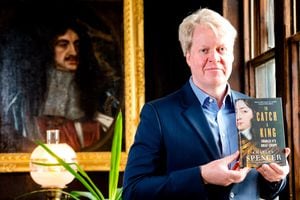To Catch A King: Defining moment for country comes to life in book
IT was one of the most important and defining moments in Britain’s history and the role of the West Midlands was pivotal.

The year was 1651 and on the run from Oliver Cromwell’s army, wanted man Charles II refused to give up on his dreams of taking the throne.
His father Charles I had already been beheaded two years previously, while thousands of his soldiers had been killed, with even more taken prisoner in the Civil War.
Had he been captured it was almost certain he would face execution – and the history books wouldn’t quite be the same as they are today.
After defeat at the Battle of Worcester, Charles fled through the Staffordshire countryside and hiding in a great oak tree at Boscobel House, near Bishops Wood on the Staffordshire and Shropshire border, became his only hope when Cromwell’s men came calling.
His escape was so famous that more than 400 Royal Oak pubs stand open across the land in tribute.
Last year, the tale of Charles’ escape was brought to life by Princess Diana’s brother Earl Spencer in the critically acclaimed To Catch A King.
The story focuses on the weeks a young 21-year-old Charles II spent on the run before escaping to France after defeat at the Battle of Worcester.
From being given his first proper bed in days at Moseley Old Hall near Wolverhampton and his time at the Giffard family’s Boscobel House to eating bread crusts and drinking beer on streets near Stourbridge, Earl Spencer based the book on archived material and the action-packed read offers a true account of the King’s dramatic escape.
“They had reached Kinver, 19 miles north of Worcester, when Walker, the guide, confessed he was lost,” to Catch a King reads. “Charles now realised how exhausted he was after a day of fighting, and announced to his companions that all he craved was somewhere safe to rest for a few hours.
“The Earl of Derby proposed Boscobel House, where he had hidden after his recent defeat at Wigan Lane, as a possible haven for the king.
“It was tucked away in thick woodland, the people the Earl of Derby had encountered there were very much to be trusted; and the owners were Roman Catholics who had built hiding places for their priests.”
Packed with interesting tales at landmarks across the region, the book tells how Charles chose to trust those at Boscobel House and how, owner Charles Giffard, who had come from a family with a long history of royal service, did not hesitate in offering him a secluded hiding spot.
He was helped there by ardent royalist Francis Yates, from Brewood, and together they passed through Stourbridge, before being offered a crust of bread and beer a mile north from there.
Himley, Wombourne and Wrottesley Woods also feature – but instead of heading straight to Boscobel – Yates opted to take Charles to the more secluded White Ladies Priory, which stood a further mile inside the dense woodland of Brewood Forest.
And disguising the King was the next task. The book added: “The first priority was to disguise the extremely tall king with clothes that fitted. Given the uncommon height of six feet two inches, at a time when few men were taller than five foot six, the costume ended up being a composite drawn from the wardrobes of the various people to hand.
“Charles Giffard told the lankiest of the Penderel brothers, William, to bring his spare clothes to be tried on by the king. These were a tunic, breeches of a rough green cloth, and a deerskin leather jerkin, which replaced Charles’s buff coat, inset with rich bands of gold lace and a fine doublet.” The next day, Charles planned to escape towards France over the River Severn and through Wales – but in Madeley, which now falls under the borough of Telford, the town was heavily guarded.
Instead, they headed towards the original target of Boscobel House, where he would soon spend hours hidden in the branches of the great oak.
“They arrived at Boscobel at 3am on September 6. The nine miles from Madeley had taken four hours to cover, because of the dark, the roughness of the route travelled and Charles’ feet. The king had, by this stage, been walking for two hours straight in agony.”
White Ladies was raided soon after by the Cromwell’s forces and Charles was warned they would be heading to Boscobel next.
With enemy patrols soon scouring the woodland area for the defeated king, Charles fled to the tree with Major William Careless where he famously hid in the thick leaves and branches. “Convinced by Careless that staying on at Boscobel in the meantime would lead to his certain capture, he headed off with the major to hide in the oak tree for the day.”
It soon became the most celebrated tree in England.
Today, a descendant of the original Royal Oak still stands in the same spot at Boscobel Hall – despite being badly damaged in a lightning storm just under 20 years ago.
In an interview with the Express & Star, Earl Spencer said: “The more I looked into it, the more fantastic I realised the story was. It is very dramatic.
“I also think that these days there is more of an appetite for history books that concentrate on a moment in time when everything hangs in the balance.”
To Catch A King by Charles Spencer is published in hardback by William Collins, priced £20.





